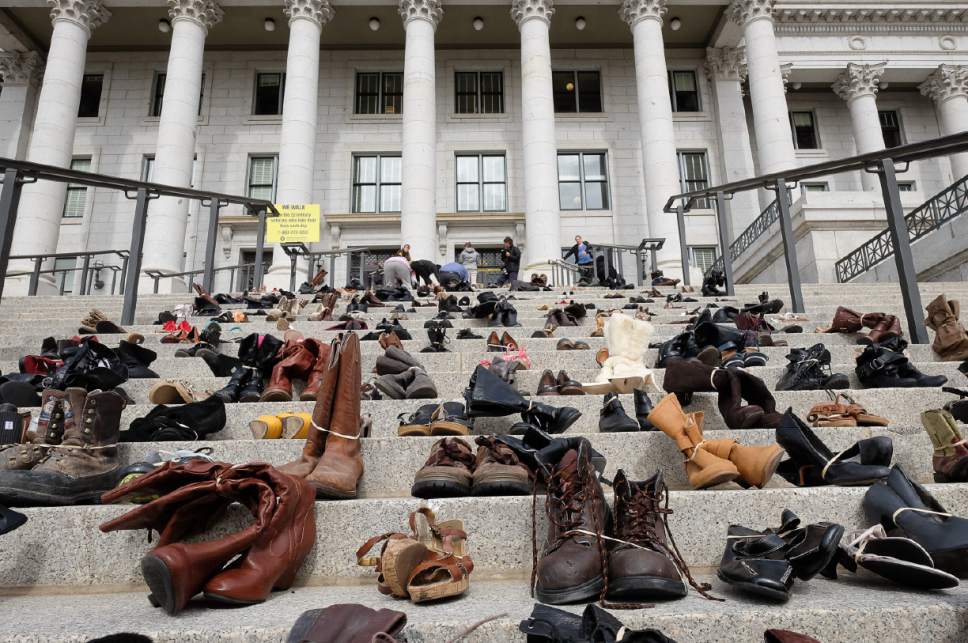This is an archived article that was published on sltrib.com in 2017, and information in the article may be outdated. It is provided only for personal research purposes and may not be reprinted.
Health officials have been effectively blocked from gathering survey data on gay, lesbian and bisexual high school students after key school districts threatened to withdraw.
The Utah Department of Health sought in 2016 to include a question regarding sexual orientation in an annual joint federal-state survey on health risks, known as the Youth Risk Behavior Survey (YRBS) and conducted in conjunction with the Centers for Disease Control and Prevention.
Health department and CDC officials contend that an additional question on sexual orientation could provide valuable insights into the Utah's surging teen suicide rates.
"You can't learn anything from a death certificate about whether [LGBTQ] kids have a higher rate of suicide in Utah," said Michael Friedrichs, an epidemiologist and statistician for UDOH. "That is why we felt it was important [to add the question] so we could collect what data we could to generate some known facts."
The CDC recently visited Utah to investigate the climbing suicide numbers and Friedrichs said the agency specifically recommended the state "improve surveillance for a variety of topics, including sexual orientation" to help spot trends in what officials are calling an epidemic.
But after the question was added in fall 2016, several school administrators voiced concerns. Officials in the Davis and Cache County school districts threatened to not administer the survey at all, said Friedrichs, who works in UDOH's Bureau of Health Promotion.
Without at least 60 percent student participation statewide, YRBS data for the state would be statistically invalid. Utah didn't meet the participation requirement in 2015, and Friedrichs said two districts opting out of the survey would lead the state down a similar path, so the question was removed.
Davis School District opposed the question because there wasn't enough time to review and discuss it once it was proposed, said Logan Toone, the district's director of assessment, research and evaluation.
"YRBS, though an anonymous survey, can be an emotionally challenging experience for our students, and we didn't feel it was appropriate to ask our students to identify their sexual orientation using the proposed question in a school classroom," Toone said in an email.
"We feel that the important discussions surrounding the sensitive issue of sexual orientation among our teens warrant more than a seemingly declarative/definitive multiple-choice question on a survey," he said.
Repeated attempts to reach officials in the Cache School District for this story were unsuccessful.
Adolescent suicides in Utah, defined as children ages 10 through 17, doubled from 22 in 2012 to 44 in 2015, according to UDOH data. Preliminary numbers for 2016 show 33 suicides among the age group.
The CDC reported that lesbian, gay and bisexual teens are nearly four times more likely to attempt suicide than their heterosexual counterparts.
Utah's version of the YRBS survey already includes questions about behaviors contributing to violence and injury; alcohol, tobacco and drug use; unhealthy diets; and inadequate exercise. Its 2017 survey, being administered now, includes 98 questions, and all answers are anonymous with no ties to students, schools or school districts.
States can add questions to their surveys from an optional question bank, which includes topics such as sexual behaviors contributing to unwanted pregnancies, sexually transmitted disease and sexual orientation. Utah is one of 25 states that does not ask any questions related to sexual orientation, according to national officials involved with YRBS.
Friedrichs said Utah has never included questions about any sexual behaviors.
The omitted question on sexual orientation read "Which of the following best describes you?" with answers including heterosexual (straight), gay or lesbian, bisexual or unsure. The survey did not include answers regarding transgender or gender-fluid identities.
Friedrichs said he intends to work with schools officials to include the question on the 2019 survey.
Toone said he welcomed that discussion, saying he hopes it would give school districts a better understanding of the issue and "make sure the question will allow all students to respond comfortably and confidently."
LGBTQ advocates in Utah say national suicide trends among gay teens alone demonstrate the importance of collecting youth-based data about sexual orientation. Troy Williams, executive director of the gay-rights advocacy group Equality Utah, said the justification for not having the data is "based on fear and bias and children's lives are at stake."
The Utah Legislature's recent approval of SB196 was a step in the right direction, Williams said. The bill repealed language prohibiting teachers from discussing homosexuality in health instruction in public schools.
"We have to examine our social institutions, our churches, schools, businesses and our government and ask some hard questions," Williams said. "Do policies we have condemn and exile or do they embrace and include? We have to do everything we can to make [LGBTQ] youth feel valued and loved."
Andrea Hood, suicide-prevention coordinator for the UDOH, said collecting data on sexual orientation could give schools a chance to develop programming specifically targeting LGBTQ youths.
She added that drawing attention to issues of suicide and other health-risk factors for specific groups of teens could give schools and administrators a clearer perspective on the needs of their students.
"We need to do more than just general preventions," she said. "It needs to be specific to help these LGBTQ kids. It's what's lacking in Utah."
Twitter: @kelgiffo





